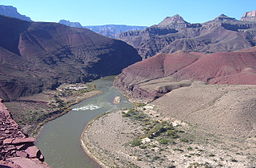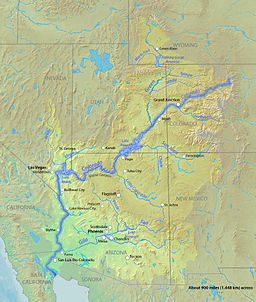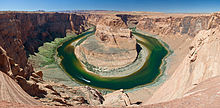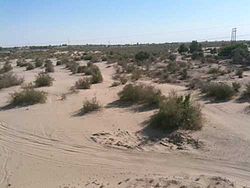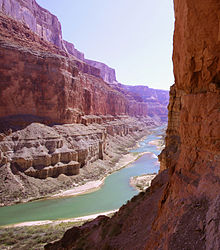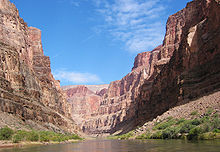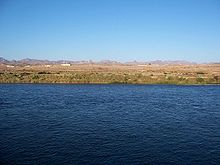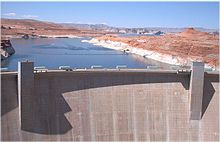- Colorado River
-
This article is about the river that flows through the Grand Canyon. For other rivers named Colorado, see Colorado River (disambiguation).
Colorado River Xakxwet (Maricopa), ʼAha Kwahwat (Mojave), Ha Ŧay Gʼam (Havasupai-Hualapai-Yavapai), Tó Ntsʼósíkooh (Navajo), Río Colorado (Spanish) A remote stretch of the Colorado River from the Escalante Route in the Grand CanyonCountries United States, Mexico States Colorado, Utah, Arizona, Nevada, California, Baja California, Sonora Part of Gulf of California Watershed Tributaries - left Fraser River, Eagle River, Roaring Fork River, Gunnison River, Dolores River, San Juan River, Little Colorado River, Bill Williams River, Gila River - right Green River, Dirty Devil River, Escalante River, Kanab River, Virgin River, Hardy River Source Continental Divide at La Poudre Pass - location Rocky Mountain National Park, Colorado, United States - elevation 10,184 ft (3,104 m) [1] - coordinates 40°28′20″N 105°49′34″W / 40.47222°N 105.82611°W [2] Mouth Colorado River Delta, Gulf of California (Sea of Cortez), Baja California / Sonora, Mexico - elevation 0 ft (0 m) - coordinates 31°39′N 114°38′W / 31.65°N 114.633°W [3] Length 1,450 mi (2,334 km) [4] Basin 246,000 sq mi (637,000 km2) [4] Discharge for Lee's Ferry, 25.6 kilometres (15.9 mi) below Glen Canyon Dam - average 17,850 cu ft/s (500 m3/s) [5][n 1] - max 300,000 cu ft/s (8,500 m3/s) - min 700 cu ft/s (0 m3/s) The Colorado River (Maricopa: Xakxwet, Mohave: 'Aha Kwahwat,[6] Havasupai: Ha Ŧay Gʼam or Sil Gsvgov,[7] Spanish: Río Colorado), is a river in the Southwestern United States and northwestern Mexico, approximately 2,330 kilometers (1,450 mi) long,[4] draining a part of the arid regions on the western slope of the Rocky Mountains. The watershed of the Colorado River covers 637,000 km2 (246,000 sq mi) in parts of seven U.S. states and two Mexican states.[4] The natural course of the river flows from the Continental Divide at La Poudre Pass in Rocky Mountain National Park, Colorado, into the Gulf of California between the Baja California peninsula and mainland Mexico.
Large diversions of water for irrigation, and to a much lesser extent to supply cities combined with significant evaporation losses from its reservoirs have dewatered the lower course of the river downstream of Yuma, AZ, above the Colorado River Delta, resulting in it no longer consistently reaching the Gulf of California. More than 20 major dams have been built on the Colorado River and its tributaries.
Contents
Course
Headwaters
The Colorado River rises on the Continental Divide at La Poudre Pass, in Rocky Mountain National Park, about 40 km (25 mi). north of Lake Granby, as a tiny stream draining a wet meadow. At the river's headwater, the Continental Divide forms the boundary between the Gulf of Mexico and Pacific Ocean watersheds of North America, between Colorado's Grand and Larimer counties, and the northern boundary of Rocky Mountain National Park.
The river's first diversion is here at its headwater. The Grand Ditch redirects water from the Never Summer Mountains, which would have flowed into the Colorado River, to instead flow across the divide through La Poudre Pass to irrigate farmland to the east.
About a mile (1.5 km) downstream from its source, the Colorado River has carved its first canyon, the narrow, deep Little Yellowstone Canyon. It then flows through the broad Kawuneeche Valley, where it is joined by U.S. Highway 34, which will roughly parallel it to the town of Granby. It finally exits Rocky Mountain National Park, flowing into Shadow Mountain Lake and then into Lake Granby, which are portions of the Colorado-Big Thompson Project, a large trans-basin water storage and delivery project that diverts water from the Colorado River under the Front Range mountains to provide an agricultural and municipal water supply for the northern Front Range and plains of Colorado.
Starting in Granby, the river is roughly paralleled by U.S. Highway 40 to the town of Kremmling, and by the tracks of the Union Pacific Railroad until about the Utah border, carrying the Amtrak California Zephyr passenger train. The canyons and valleys of the Upper Colorado River are among the scenic attractions for passengers on this rail route.
Just downstream from Granby, the Colorado is joined by the Fraser River. At Hot Sulphur Springs the river flows through Byers Canyon and then is joined by the Williams Fork. Just below Kremmling it is joined by the Blue River before flowing through Gore Canyon, famous for its challenging rapids for the sport of whitewater rafting, and where it drops significantly until Colorado State Highway 131 crosses at the village of State Bridge. It meets the Eagle River in the town of Dotsero, from where Interstate 70 will parallel the Colorado almost until it enters Utah.
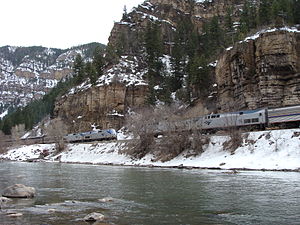 The eastbound and westbound California Zephyrs meet in Glenwood Canyon, alongside the Colorado River.
The eastbound and westbound California Zephyrs meet in Glenwood Canyon, alongside the Colorado River.
It then flows through Glenwood Canyon, emerging at the city of Glenwood Springs where it is joined by the swift flowing Roaring Fork River. West of Glenwood Springs, the Colorado runs through De Beque Canyon and the Grand Valley and is joined by the Gunnison River at Grand Junction. Though many of the river's uppermost tributaries within Colorado are small, there are exceptions, such as the Gunnison and Roaring Fork Rivers, in which massive amounts of water flow. From there it flows in an arc west-north through Ruby Canyon, where it crosses the Utah state line, into Westwater Canyon. Here, the Colorado ranges from 200 to 1,200 ft (60 to 370 m) wide and from 6 to 30 ft (2 to 9 m) in depth with occasional deeper areas.
Canyons
The river turns southwest near Fruita, Colorado, and is joined by the Dolores River soon after entering Utah. It partially forms the southern border of Arches National Park near Moab, Utah, and then passes by Dead Horse Point State Park and through Canyonlands National Park where it is met by one of its primary tributaries, the Green River. The Colorado River then flows into Lake Powell, formed by the Glen Canyon Dam, where the San Juan River joins. Below the dam, water released from the bottom of Lake Powell makes the river clear, clean, and cold. Just south of the town of Page, Arizona, the river forms the dramatic Horseshoe Bend, then at Lees Ferry is joined by another tributary, the warm, shallow, muddy Paria River, and begins its course through Marble Canyon. Here, the Colorado River ranges from 175 to 700 ft (50 to 210 m) in width and 9 to 130 ft (3 to 40 m) in depth.
At the southern end of Marble Canyon, the river is joined by another tributary, the Little Colorado River, and the river then turns abruptly west directly across the folds and fault line of the plateau, through Grand Canyon and Grand Canyon National Park, which is 349 km long (217 miles) and from 6 to 30 km (4 to 20 miles) between the upper cliffs. The walls, 4,000 to 6,000 ft (1,200 to 1,800 m) high, drop in successive escarpments of 500 to 1,600 ft (150 to 490 m), banded in splendid colors toward the narrow gorge of the present river.
Below the confluence of the Virgin River in Nevada, the Colorado River abruptly turns southward. Hoover Dam, built during the Great Depression, forms Lake Mead, a popular recreation site as well as the supplier of most of the water for the Las Vegas metropolitan area. From Hoover Dam, the river flows south and forms part of the boundary between Arizona and Nevada and between Arizona and California. Along the California-Arizona reach of the river, four additional dams are operated to divert water for municipal supplies and agricultural irrigation, and for recreational uses. Lake Mohave, formed by Davis Dam, lies in the southern portion of the Lake Mead National Recreation Area. Lake Havasu, formed by Parker Dam, provides recreation as well as the home of the retired U.K. London Bridge, now the New London Bridge. The two remaining dams supply irrigation water: Palo Verde Diversion Dam and Imperial Dam. Here, the Colorado River ranges in width from 700 to 2,500 ft (200 to 800 m) and from 8 to 100 ft (2 to 30 m) in depth.
Final course
Below the Black Canyon the river lessens in gradient and in its lower course flows through the Colorado Desert in a broad sedimentary valley's distinct estuarine plain upriver from Yuma, where it is joined by the Gila River. The channel through much of this region is bedded in a dike-like embankment lying above the floodplain over which the escaping water spills in time of flood. This dike cuts off the flow of the river to the remarkable low area in southern California known as the Salton Sink in the Coachella Valley, and the Imperial Valley. The Salton Sink and its Salton Sea are located below sea level; therefore, the descent from the river near Yuma is very much greater than the descent from Yuma to the Gulf of California.
The lower course of the river—which forms the border between the Mexican state of Sonora on the mainland and the state of Baja California on the Baja California peninsula—is a dry or small stream most of the year due to the river being diverted into the Imperial Valley's irrigation source, the All-American Canal. Several miles from its mouth, the Hardy River enters, adding a little water to the often dry Colorado before it reaches the Gulf of California.
Prior to the mid 20th century, the Colorado River Delta provided a rich estuarine marshland; while today it is now essentially desiccated, the river is still an important ecological estuary resource. The estuary of the Colorado River was subjected to a major tidal bore that has almost disappeared with the drastic reduction in the freshwater flow following the irrigation diversions of the Colorado River, and to a lesser extent because of some dredging of the estuary channel.[8] The first historical record of the tidal bore was that of the Croatian missionary in Spanish service Father Ferdinand Konščak on 18 July 1746. During spring tide conditions, the tidal bore formed in the estuary about Montague Island and propagated upstream. It was called locally 'El Burro' or 'burro'. Today the tidal bore is rarely seen although there are still some anecdotal observations.
Discharge
The Colorado River's discharge has been modified by large dams and diversions for irrigation, resulting in a reduction of the river's discharge along its lower course. The diversions are principally responsible for reducing the average flow of the Colorado near its mouth from about 22,000 cubic feet per second (623 m3/s) between 1903 and 1934 to less than 4,000 cubic feet per second (113 m3/s) from 1951 to 1980. Annual flow near the river's mouth in 1984 was 17,500 cubic feet per second (496 m3/s) due to record-breaking precipitation.[4] From 1975 to 2004 the average flow at the US–Mexico border was 2,661 cubic feet per second (75 m3/s).[9]
The United States Geological Survey (USGS) operates a number of stream gauges along the Colorado River. A gauge on its middle course, at Lee's Ferry, 25.6 kilometres (15.9 mi) below Glen Canyon Dam, recorded an average discharge of 17,850 cubic feet per second (505 m3/s) between 1895 and 2009. The maximum flow recorded at this station was 220,000 cubic feet per second (6,230 m3/s) on June 18, 1921. The minimum flow was 700 cubic feet per second (20 m3/s), January 23–24, 1963, resulting from the initial closure of Glen Canyon Dam.[5] The mean annual discharge recorded by downriver gauges are all lower than at the Lee's Ferry gauge, and includes 13,860 cubic feet per second (392 m3/s) below Hoover Dam,[10] 14,190 cubic feet per second (402 m3/s) below Davis Dam,[11] 12,040 cubic feet per second (341 m3/s) below Parker Dam,[12] 1,724 cubic feet per second (49 m3/s) below the Laguna Diversion Dam,[13] and 1,988 cubic feet per second (56 m3/s), for 2008–2009, at the Northerly International Boundary (NIB) with Mexico, 1.8 kilometres (1.1 mi) above Morelos Dam. This NIB gauge has operated since 1950 and is, via the International Boundary and Water Commission, the accounting point for the 1944 International Treaty detailing water delivery to Mexico.[14]
The last stream gauge is at the Southerly International Boundary (SIB), where the river leaves the United States altogether. Although the river flows about 123 kilometres (76 mi) from the SIB to its mouth, no discharge data has been collected since 1983. The amount of water that reaches the mouth of the Colorado River is not known. It is often estimated to be similar to that recorded at the SIB even though this is probably inaccurate. Accounts of flow below the SIB range from zero to a level equal to that recorded at the SIB. The average annual discharge at the SIB from 1975 to 2004 was 1,928,000 acre feet (2.378×109 m3). During that period's 18 "non-surplus" years the flow at the SIB was only 865,000 acre feet (1.067×109 m3) per year. There has been no measurable flow at all at the SIB for extended periods during many years. In 1996 no flow was recorded on any day of the entire year. Nonetheless, a small amount of water flows into the Colorado River below the SIB, mostly from irrigation returns, the Hardy River, and effluent from the cities of San Luis Río Colorado and Mexicali.[9]
Geology
About 100 million years ago, during the Cretaceous period, the southwestern United States was still part of the Western Interior Seaway and the Pacific Ocean. It was only when the Farallon Plate was subducted under the North American Plate in what is now known as the Laramide orogeny about 75 million years ago, did the Rocky Mountains thrust out of the flat seascape, and thus the Colorado River was born. The Upper Colorado, Gunnison, and San Juan Rivers all formed in this way. However, instead of cutting southwest across the Colorado Plateau to the Gulf of California, the Colorado was instead diverted northeast into present-day Wyoming by the Colorado Plateau to join the headwaters of the North Platte River. Later, with the uplift of mountain ranges in northern Utah and southern Wyoming, the Colorado was instead diverted eastwards, into the Great Basin, where in flood, it would sometimes reach the Snake River.
During the Miocene, the lower course of the river began to form, completely independent of the upper Colorado. It began as the entrenched gorge of the Kanab Creek, a northern tributary of the Colorado in the present-day Grand Canyon. The waters from the Colorado Plateau flowed into the Kanab, joining other tributaries and flowing westwards across present-day Central California, flowing into the Pacific at Monterey Bay where it is believed to have been responsible for creating the Monterey submarine canyon and its associated alluvial fan. Over millions of years, this entirely independent river slowly eroded what would become the western half of the Grand Canyon. Meanwhile, the Little Colorado River's drainage path formed in the Painted Desert, emptying into a large endorheic basin in northeastern Arizona, Hopi Lake, where it usually terminated excepting during floods. The upper Colorado River changed course between the Great Basin and the Colorado Plateau several times, cutting Marble Canyon and Glen Canyon in a northwesterly direction as it emptied back into the Great Basin, in the opposite direction of which the water now flows. Later, tectonic activity helped to tilt the land such that the flow in Marble and Glen Canyons reversed to the southwest. This explains why many of the present-day tributaries in this section, such as the Little Colorado, flow into the river at obtuse angles i.e. opposite to the river's present flow direction.
The most widely believed theory is that the Colorado had been continually flowing across the Plateau for about 65 million years, slowly and steadily eroding the Grand Canyon. However, an alternative theory is that roughly 5.4 million years ago, the Colorado's flow again shifted into Hopi Lake. Hopi Lake overflowed across the Colorado Plateau in a massive flood, eroding the Grand Canyon in a much shorter time period than previously believed. Either way, uplift of the high mountain ranges in California, such as the Sierra Nevada, Tehachapis, and Transverse Ranges then blocked the path of the Colorado and diverted it southwards into the Gulf of California, where it began to build a vast delta. This delta eventually walled off the northern part of the Gulf of California from the rest of the body of water, creating the Salton Sink, which dried up except when the Colorado changed course to empty into the basin, as it did in 1904 creating the Salton Sea.
History
First inhabitants
Several groups of ancient nomadic people, descended from Uto-Aztecan speakers, sparsely populated the Colorado Plateau thousands of years ago. In about 6,000 B.C., the Hisatsinom, predecessor of the Puebloan peoples, emerged near the Four Corners region around the San Juan River, while about 500 B.C., people of the Fremont culture began to populate the area around the Green River and the eastern part of the Great Basin.[15] It was not until about 700 A.D. that the ancestral Puebloans began to cultivate crops for food, and the famous cliff dwellings for which they are best known did not come into being until past 1000 A.D.[16]
Native American groups such as the Anasazi, Navajo, Pueblo and Hohokam Indians later lived on the arid lands of the Colorado Plateau, using water from the Colorado and its tributaries for irrigation. These two native groups formed large agriculture-based societies which each only lasted for a few hundred years, starting from around 200 B.C.[17] The Anasazi inhabited the northern part of the Plateau and the foothills of the Rockies, in areas such as Chaco Canyon near the San Juan and Green Rivers, while the Hohokam lived in present-day central Arizona in the Gila River valley around the confluence with the Salt River. Both the Anasazi and Hohokam utilized extensive systems of canals to water their farmland, with over 352 kilometres (219 mi) utilized by the Hohokam alone.[18]
Native civilization reached its peak from 600 to 900 A.D. in the Colorado watershed, but began a general decline afterwards. Around the 13th century and 14th century, near the height of a second peak, the Anasazi and Hohokam cultures suddenly "disappeared" from the lands around the Colorado River.[19] Their demise is believed to be linked to the overuse of water for irrigation combined with a severe half-century drought. Intensive irrigation raised the water table while increasing the salinity of the soils used for farming, eventually making them unsuitable. Flash floods during the 12th century and 13th century were probably responsible for the demise of the Chaco culture, and the Navajo and Puebloan people who lived in the high desert in the Four Corners region near present-day Lake Powell declined as well.[20]
It is believed that during the severe droughts of the three centuries surrounding the 13th century, many of the peoples that once inhabited the upper regions of the Colorado watershed migrated to the Rio Grande valley and the Painted Desert in the Little Colorado River region.[21] Many of the people in the Hopi and Zuni tribes of the Sonoran Desert, as well as the Acoma and Laguna people on the Rio Grande, are believed to be descended from the ancient inhabitants of the northeastern Colorado Plateau.[20]
Early records
The existence of the Colorado River was first noted in the records of written history in September, 1539, when Francisco de Ulloa sailed to the head of the Gulf of California and rowed a short distance upstream.[22] It was next seen by Hernando de Alarcon who in 1540 led the maritime contingent of Coronado's expedition. The plan was to meet the land based force and resupply them. Alarcon ascended the river about 85 miles to the limit of navigation near present-day Yuma, Arizona. He waited for Coronado, but eventually despaired, cached some supplies and correspondence, left a note on a tree, and departed. Coronado's land forces never reached that location, but Melchior Diaz, on his third expedition, went to see if he could establish contact with Alarcon. By the time he reached the Colorado, however, Alarcon had already left. The Native Americans told him what they knew of Alarcon's presence and that he had left a cache of supplies. Diaz found the note and the supplies. Diaz named the river Rio del Tizon ("River of Embers" or "Firebrand River") based on a practice used by the natives for warming themselves.[23] Meanwhile, Coronado (who at the time was near Zuni, New Mexico) had learned from one of his scouting parties that the natives spoke of a large river to the west. He sent Garcia Lopez de Cardenas to lead a contingent of men to find this river. They did find it at what is now known as the Grand Canyon, becoming the first people of European background to see it. Their failed attempts at reaching the river led them to conclude that it would not be possible to be supplied via the Gulf of California and the river.
 Colorado River in the Grand Canyon from Desert View
Colorado River in the Grand Canyon from Desert View
The following year, Francisco de Bolaños sailed to the mouth of the river on the Gulf of California. One of his pilots, Domingo del Castillo, prepared a map of the Mexican coast. He charted three rivers at the head of the gulf and named them Brazo de laguna p., Rio de buena Guia p., and Brazo de Mira flores p.. The latter of these three is the longest.[24] Later references suggest that Brazo de Mira flores referred to what is now called the Gila River, and that Rio de buena Guia was his name for the Colorado. In spite of these records, the legend and mapmaking error showing an Island of California persisted for more than a century, especially among European cartographers.
Comparisons of 17th, 18th, and early 19th-century maps reveal a parade of names being applied to the Colorado and its tributaries, as well as a variety of courses, as cartographers learned or made up the geography of the region.[25] On a map by Nicholas Sanson (1650) the R. del Tecon and the R. de Coral share a common mouth on the gulf. A number of maps show the Gila River (sometimes just the lower, sometimes the whole) as the Rio Grande de las Apostoles. A 1763 map by Emanuel Bowen equates the Apostles with the del Coral. A 1720 map by Fer Nicholas labels the main body of the Colorado as Rio del Tison, and a tributary of the Apostles/Gila as Rio Colorade. In 1703 Guillaume de L'Isle showed a Rio de buena esperanza as a major tributary of the Tison, but it is not clear if this tributary corresponds better with the Little Colorado or the San Juan. A map by Herman Moll (1720) charts the Tison and the Gila with separate mouths. Upriver from a tributary of the Tison that would appear to correspond with today's Virgin River, the name for the main channel is given as R. of Good Hope. On other maps Good Hope/Buena Esperanza are transferred to a tributary of the Gila. A map of 1757 gives the name of the main course as Rio Colorado de los Martyres. A map of 1781 by Jonathan Carver charts a major split in the river and labels the eastern branch "Colorado" and the western branch Martyres. A map from 1758 by Didier Robert de Vaugondy applies the name Colorado to a river that reaches north to the headwaters of the Missouri, best corresponding to today's Green River. When Jedediah Smith first reached the lower Colorado in 1826, he first called it the Seedskeedee, as the headwaters of the Green River were known to the trappers, but also noted that the natives called it the Colorado.[26]
The Colorado River from Laughlin
It is not clear when or why the name "Colorado" first replaced "Tizon" (Tecon/Tison), which had been the most common name on maps since 1540. Among the maps in the Library of Congress, every use of "Colorado" (or Colorade) from 1720 and before is applied to a tributary of what is now the Gila River that seems best to correspond with today's Verde River.[27] The earliest map in that collection that replaces "Tizon" with "Colorado" is a map from 1743.[28]
The map that resulted from Escalante's expedition in 1776 labels the main channel as the Colorado up to the confluence of the Nabajoo and Zaguananas rivers. The associated information leads one to conclude that the Nabajoo corresponds to the San Juan and the Zaguananas to the Colorado from there to the Dolores River. On this map the Colorado above the Dolores is called the Rafael, and the Green River (named Buenaventura River) is erroneously diverted to the southwest and to what is now called Sevier Lake. Where Escalante's journal records his crossing of the San Rafael, he notes that the Native Americans knew this river as the Colorado. He also notes that the natives said this river had it source in a distant lake, but the lake is not charted on the resulting map. It is evident from a number of maps of the period that people were not aware of the distance between the Colorado's confluence with the Dolores and the western slopes of the Front Range. On a map from 1847 by John Disturnell, the Rafael is replaced with the Green River, while the upper Colorado (or more correctly, what would be called the Grand River) is not shown at all.
Grand River
"Grand River" is the name applied to the Colorado River from its headwaters in Rocky Mountain National Park to its confluence with the Green River in Utah from about 1836 to 1921.[29] This gave rise to several now orphaned names including Grand Lake, Grand Valley, Grand Junction, Grand County, Colorado, and Grand County, Utah. The earliest appearance of this name on a map could be on the map by Henry Schenck Tanner (1836).[30] The name there replaces the name of Rio Rafael, which appears on many earlier maps. The head of this branch of the Colorado is shown as at about the same latitude as Longs Peak in Colorado. There is nothing charted that corresponds to the Green River, nothing that corresponds with the course of the Dolores (even though some earlier maps did show the Dolores with reasonable accuracy), and the headwaters of both the Rio Grande ("Rio del Norte") and especially the Arkansas River are shown to reach to a higher latitude.
A map by David H. Burr (1839)[31] shows the "Colorado River of the West" flowing from the headwaters of the Green River to the Gulf of California, with the "Grand River" as a tributary branching to the east, the third tributary upriver from the Nabajoo (San Juan). The Green River is not separately named. The headwaters of the Grand are depicted as being very close to the headwaters of the Rio Grande (which is labeled "Rio Bravo del Norte") as well as those of the Arkansas River. A textual note on the map indicates that little is known of this area.[32] In 1859, a U.S. Army topographic expedition led by Captain John Macomb located the confluence of the Green River with the Grand River in what is now Canyonlands National Park.[33] The Macomb party designated the confluence as the source of the Colorado River.
In 1921, U.S. Representative Edward T. Taylor petitioned the Congressional Committee on Interstate and Foreign Commerce to rename the Grand River as the Colorado River. On July 25, 1921 the name change was made official in House Joint Resolution 460 of the 66th Congress, over the objections of representatives from Wyoming and Utah and the United States Geological Survey which noted that the drainage basin of the Green River was more than 70% more extensive than that of the Grand River,[34] although the Grand carried a slightly higher volume of water at its confluence with the Green.
Elevation summary
Approximate heights above sea level at several key locations:
Feet Meters Location 10184 3104 Colorado headwaters (Rocky Mountains) 6100 1850 midway to Colorado-Utah border 4300 1300 Colorado-Utah border 3850 1170 midway to Utah-Arizona border 3700 1130 Utah-Arizona border (Wahweap Bay on Lake Powell) 3000 900 midway to Grand Canyon (Rider Point near Bitter Springs, Arizona) 2800 850 Grand Canyon North Rim 2500 760 Grand Canyon South Rim 1200 365 Lake Mead (above Hoover Dam) 600 183 below Hoover Dam 485 150 California-Nevada-Arizona border 100 30 California-Arizona-Mexico border Note that the significant difference between the present height of the rim of the Grand Canyon (about 2440 m; 8000 ft) and the levels at which the river enters/exits it gives rise to the geologic theory that uplift must have begun around the same time the river began flowing through it and eroding it (since rivers do not run uphill, it would have otherwise followed some other path around the uplifted region). Estimates for the beginning of this erosion/uplift process range from 5 to 70 million years ago.
Engineering
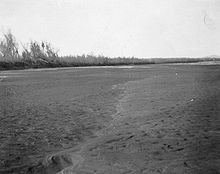 The Colorado River dried up in 1904 when its flow was accidentally diverted into the Alamo Canal, creating what is known today as the Salton Sea.
The Colorado River dried up in 1904 when its flow was accidentally diverted into the Alamo Canal, creating what is known today as the Salton Sea.
In the autumn of 1904, the river's waters escaped into a diversion canal a few miles below Yuma, Arizona, creating the New River and Alamo River, and over two years re-formed the Salton Sea in the Salton Sink of California's Coachella Valley. The river re-created the Salton Sea, a great inland sea in the Salton Sink, an area that it had frequently inundated before. For example, in 1884 and 1891 the river practically abandoned its regular course through Mexico to the Gulf of California, and flowed into the Salton Sink. However, it was effectively dammed in the early part of 1907 and it returned to its normal course, although from which there was still much leakage to the Salton Sea. In July 1907 the permanent dam was completed, keeping the Colorado's usually normal course from the Black Canyon through the Colorado Desert basin towards the Gulf of California.
The Colorado River is a major and in some cases life-sustaining source of water for irrigation, drinking, and other uses by people living in the arid American southwest. Allocation of the river's water is governed by the Colorado River Compact, a 1922 agreement towards seven U.S. states in the Colorado River basin governing the allocation of the water rights to the river's water among the parties of the interstate compact. More than ten dams have been built along the river, beginning with Shadow Mountain Dam in western Colorado and ending with Morelos Dam on Arizona's border with Baja California. The first dam on the Colorado, Hoover Dam (originally Boulder Dam, and the largest in the world upon completion) was finished in 1936. Its impoundment of the river in the Mojave Desert creates Lake Mead, which provides water for irrigation and the generation of hydroelectric power. Since the completion of dams, the majority of the river in normal hydrologic years is diverted for agricultural and municipal water supply. The Colorado's last drops evaporate in the Sonoran Desert, more than 60 miles (97 km) before the river reaches the Gulf of California.
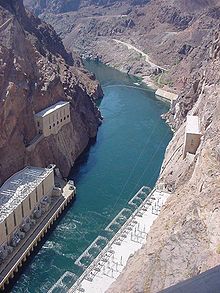 The river seen from the Hoover Dam
The river seen from the Hoover Dam
Almost 90% of all water diverted from the river is for irrigation purposes. The All-American Canal is the largest irrigation canal in the world and carries a volume of water from 420 to 850 m³/s (15,000 to 30,000 ft³/s), making it larger in volume than New York's Hudson River. The canal's waters are used to irrigate the fertile Imperial Valley orchards and crops, formerly a Sonoran Desert ecosystem where several years can pass between measurable rainfalls. Hydrology transport models are used to assess management of the river's flow and water quality.
Several cities such as Phoenix and Tucson (Central Arizona Project-CAP), Los Angeles and San Bernardino (Colorado River aqueduct), Las Vegas, Nevada, and San Diego, California have aqueducts leading all the way back to the Colorado River. The Central Arizona Project (CAP) canal, which was begun in the 1970s and finished in the 1990s, begins at Parker Dam and runs all the way to Phoenix and then Tucson to supplement those cities' water needs.
The lower Colorado is navigable by moderate to large-sized craft. The lower river from Davis Dam to Yuma is navigable by large paddlewheel boats and river barges, but commercial navigation on the river is unimportant because the river is cut off from the sea, making other means of transportation more efficient in the region. Before the railroads arrived, the lower Colorado River from the sea to near present-day Laughlin, Nevada was an important means of transportation via large steamers. Most of the rest of the river (and reservoirs), excluding the rapids in the canyons, is navigable by small to moderate-sized river craft and power boats.
Fish species
The Colorado River basin is home to fourteen native species of fish. Four are endemic and endangered: Colorado pikeminnow (formerly Colorado squawfish), razorback sucker, bonytail chub, and humpback chub. The Upper Colorado River Endangered Fish Recovery Program is a controversial[citation needed] effort by the US Fish and Wildlife Service, in conjunction with the Arizona Game and Fish Department, the Colorado Division of Wildlife, and the Utah Department of Wildlife to recover these endangered fish.
 The Colorado River in James M. Robb - Colorado River State Park as the morning sun rises
The Colorado River in James M. Robb - Colorado River State Park as the morning sun rises
Fish species in the river are Brook Trout, Blue Catfish, Catfish (Channel), Carp, Crappie, Largemouth Bass, Rainbow Trout, Striped Bass, Sunfish, Sturgeon, Colorado Pikeminnow, Humpback Chub, Razorback Sucker, Bonytail Chub, Tilapia, Smallmouth bass Black Bullhead Catfish and Flathead Catfish
Environmental issues
The numerous dams on the Colorado have prevented seasonal flooding that would normally clean debris that has accumulated along the river's length. This lack of flooding has also led to erosion of sand bars in the Grand Canyon, which are crucial to wildlife.
Moab uranium tailings
Main article: Moab TailingsAtlas Mineral Corporation operated a uranium processing mill in the area of Moab, Utah, on the north bank of the Colorado River just under 5 km (about 3 miles) from downtown Moab. As a byproduct of uranium processing activities, an estimated 16 million ton pile of chemically and radioactively hazardous tailings exists. The pile is located about 700–800 feet (200–250 meters) from the Colorado River. Although no contamination has been detected, the proximity of the material to the watershed has been a concern. The Senate has authorized the U.S. Department of Energy to budget $22.8 million in 2007 to begin the project of moving the uranium tailings farther from the river. The plan is to move the contaminated materials 48 kilometres (30 mi) north to a disposal site located at Crescent Junction, Utah. The project is expected to be completed by 2028 with current funding plans, at total estimated cost of US$720 million.
See also
- Alamo Canal
- All-American Canal Bridge
- Bridge Canyon Dam
- Colorado River Compact
- Colorado River Delta
- Colorado River Irrigation Company
- Salton Sea
- Glen Canyon Dam; Lake Powell
- Hoover Dam; Lake Mead
- Parker Dam; Lake Havasu
- List of tributaries of the Colorado River
- List of Colorado River rapids and features
- List of flora of the Lower Colorado River Valley
- List of international border rivers
- List of longest main-stem rivers in the United States
- List of longest rivers of Mexico
- Powell Geographic Expedition of 1869
Notes and references
- Notes
- ^ These are the average, maximum, and minimum flows recorded during the period of record (1895–2009) for this gauge. Downriver gauges record lower flows due to dams and diversions.
- References
- ^ "USGS Topographic Maps". ACME Mapper. http://mapper.acme.com/?ll=40.47555,-105.82563&z=16&t=T. Retrieved 2 July 2010.
- ^ U.S. Geological Survey Geographic Names Information System: Colorado River
- ^ Colorado River, Mexico at GEOnet Names Server
- ^ a b c d e Kammerer, J.C.. "Largest Rivers in the United States". United States Geological Survey. http://pubs.usgs.gov/of/1987/ofr87-242/. Retrieved 2 July 2010.
- ^ a b "Water-Data Report 2009; USGS 09380000 Colorado River at Lees Ferry, AZ". United States Geological Survey. http://wdr.water.usgs.gov/wy2009/pdfs/09380000.2009.pdf. Retrieved 2 July 2010.
- ^ Munro, P et al.. A Mojave Dictionary Los Angeles: UCLA, 1992
- ^ Hinton, Leanne (1984). A dictionary of the Havasupai language.
- ^ Chanson, H. (2009). Environmental, Ecological and Cultural Impacts of Tidal Bores, Benaks, Bonos and Burros. Proceedings of the International Workshop on Environmental Hydraulics IWEH09, Theoretical, Experimental and Computational Solutions, Valencia, Spain, 29–30 October, P.A. LOPEZ-JIMENEZ, V.S. FUERTES-MIQUEL, P.L. IGLESIAS-REY, G. LOPEZ-PATINO, F.J. MARTINEZ-SOLANO, and G. PALAU-SALVADOR Editors, Invited keynote lecture, 20 pages (CD-ROM). http://espace.library.uq.edu.au/view/UQ:185349.
- ^ a b "Understanding Flows Through the Remnant Colorado River Delta: Recommendations for Streamgage Sites and Data Collection". Pacific Institute. 4 November 2005. http://pacinst.org/reports/streamgages/co_r_streamgages_report.pdf. Retrieved 3 July 2010.
- ^ "Water-Data Report 2009; USGS 09421500 Colorado River below Hoover Dam, AZ-NV". United States Geological Survey. http://wdr.water.usgs.gov/wy2009/pdfs/09421500.2009.pdf. Retrieved 2 July 2010.
- ^ "Water-Data Report 2009; USGS 09423000 Colorado River below Davis Dam, AZ-NV". United States Geological Survey. http://wdr.water.usgs.gov/wy2009/pdfs/09423000.2009.pdf. Retrieved 2 July 2010.
- ^ "Water-Data Report 2009; USGS 09427520 Colorado River below Parker Dam, AZ-CA". United States Geological Survey. http://wdr.water.usgs.gov/wy2009/pdfs/09427520.2009.pdf. Retrieved 2 July 2010.
- ^ "Water-Data Report 2009; USGS 09427520 Colorado River below Parker Dam, AZ-CA". United States Geological Survey. http://wdr.water.usgs.gov/wy2009/pdfs/09429600.2009.pdf. Retrieved 2 July 2010.
- ^ "Water-Data Report 2009; USGS 09522000 Colorado River at Northerly International Boundary, above Morelos Dam, near Andrade, CA". United States Geological Survey. http://wdr.water.usgs.gov/wy2009/pdfs/09522000.2009.pdf. Retrieved 2 July 2010.
- ^ "Fremont". Canyons, Cultures and Environmental Change: An Introduction to the Land Use History of the Colorado Plateau. Land Use History of North America. http://www.cpluhna.nau.edu/People/fremont.htm. Retrieved 2010-02-28.
- ^ Vess, Deborah. "The Anasazi". Georgia College and State University. http://www.faculty.de.gcsu.edu/~dvess/ids/amtours/anawciv.htm. Retrieved 2010-02-28.
- ^ Fradkin, Philip L. (1996). A river no more: The Colorado River and the West (2 ed.). University of California Press. pp. 18. ISBN 0-52050-564-2. http://books.google.com/books?id=w4zDFPmqkncC&printsec=frontcover&dq=colorado+river&cd=2#v=onepage&q=&f=false. Retrieved 2010-02-27.
- ^ A River No More, p. 23
- ^ Shogren, Elizabeth (2007-07-29). "Is Ancient People's End a Warning for the Future?". National Public Radio. http://www.npr.org/templates/story/story.php?storyId=12313268. Retrieved 2010-02-27.
- ^ a b "Who were the Anasazi?". Anasazi Heritage Center. U.S. Bureau of Land Management. 2008-08-18. http://www.blm.gov/co/st/en/fo/ahc/who_were_the_anasazi.html. Retrieved 2010-02-27.
- ^ A river no more, p. 19
- ^ Morrison, Samuel Eliot, The European Discovery of America - the Southern Voyages 1492-1616, Oxford University Press, New York, 1974 (page 623),
- ^ [1]
- ^ Morrison, op cit, page 625
- ^ Many of these can be viewed at the Library of Congress web site [2].
- ^ Moody, Ralph The Old Trails West, Thomas Y. Crowell Company, New York, 1963 (page 179); and Jedediah Smith's letter to William Clark as printed in the Thursday, October 11, 1827 edition of the Missouri Republican (Saint Louis), which is reproduced as an image in the Time-Life series The Old West, The Trailblazers, Time-Life Books, New York, 1973, (page 107). Jedediah Smith's spelling there is "Seeds Keeder".
- ^ [3]
- ^ [4]
- ^ Early explorers identified the Gunnison River in Colorado as the headwaters of the Colorado River. The Grand River in Colorado was later identified as the headwaters of the river, and also provides hydroelectric power and irrigation. Finally in 1916, E.C. LaRue, Chief Hydrologist of the United States Geological Survey, identified the Green River in Wyoming as the actual headwaters of the Colorado River.
- ^ [5]
- ^ [6]
- ^ A number of the rivers of the American southwest at one time or another had the word "Grand" as a part of their names, including the Rio Grande (Rio Grande del Norte) and the Gila (Rio Grande de las Apostoles).
- ^ Report of the exploring expedition from Santa Fé, New Mexico, to the junction of the Grand and Green Rivers of the great Colorado of the West, in 1859: under the command of Capt. J. N. Macomb, Corps of topographical engineers, Volume 1 @ archive.org
- ^ Many years ago, the Colorado River was just Grand, retrieved January 5, 2008.
 This article incorporates text from a publication now in the public domain: Chisholm, Hugh, ed (1911). Encyclopædia Britannica (11th ed.). Cambridge University Press.
This article incorporates text from a publication now in the public domain: Chisholm, Hugh, ed (1911). Encyclopædia Britannica (11th ed.). Cambridge University Press.External links
- Federal Department of Energy site on uranium mine tailing site.
- State of Utah site on uranium mine tailings.
- Bibliography on Water Resources and International Law Peace Palace Library
- Arizona Boating Locations Facilities Map
- Arizona Fishing Locations Map
- Where to Fish in Arizona Species Information
- Drought Watch Campaign - map of the Colorado River system showing the fill levels of major reservoirs. Last updated July 2004.
United States (Outline) History Pre-Columbian era · Colonial era (Thirteen Colonies · Colonial American military history) · American Revolution (War) · Federalist Era · War of 1812 · Territorial acquisitions · Territorial evolution · Mexican–American War · Civil War · Reconstruction era · Indian Wars · Gilded Age · African-American Civil Rights Movement (1896–1954) · Spanish–American War · Imperialism · World War I · Roaring Twenties · Great Depression · World War II (Home front) · Cold War · Korean War · Space Race · African-American Civil Rights Movement (1955–1968) · Feminist Movement · Vietnam War · Post-Cold War (1991–present) · War on Terror (War in Afghanistan · Iraq War) · Timeline of modern American conservatismTopicsDemographic · Discoveries · Economic (Debt Ceiling) · Inventions (before 1890 · 1890–1945 · 1946–1991 · after 1991) · Military · Postal · Technological and industrialFederal
governmentLegislature - Congress
Senate
· Vice President
· President pro tem
House of Representatives
· Speaker
Judiciary - Supreme Court
Federal courts
Courts of appeal
District courtsExecutive - President
Executive Office
Cabinet / Executive departments
Civil service
Independent agencies
Law enforcement
Public policy
Intelligence
Central Intelligence Agency
Defense Intelligence Agency
National Security Agency
Federal Bureau of InvestigationPolitics Divisions · Elections (Electoral College) · Foreign policy · Foreign relations · Ideologies · Local governments · Parties (Democratic Party · Republican Party · Third parties) · Political status of Puerto Rico · Red states and blue states · Scandals · State governments · Uncle SamGeography Cities, towns, and villages · Counties · Extreme points · Islands · Mountains (Peaks · Appalachian · Rocky) · National Park System · Regions (Great Plains · Mid-Atlantic · Midwestern · New England · Northwestern · Southern · Southwestern · Pacific · Western) · Rivers (Colorado · Columbia · Mississippi · Missouri · Ohio · Rio Grande) · States · Territory · Water supply and sanitationEconomy Agriculture · Banking · Communications · Companies · Dollar · Energy · Federal Budget · Federal Reserve System · Financial position · Insurance · Mining · Public debt · Taxation · Tourism · Trade · Transportation · Wall StreetSociety TopicsCrime · Demographics · Education · Family structure · Health care · Health insurance · Incarceration · Languages (American English · Spanish · French) · Media · People · Public holidays · Religion · SportsArchitecture · Art · Cinema · Cuisine · Dance · Fashion · Flag · Folklore · Literature · Music · Philosophy · Radio · Television · TheaterIssuesCategories:- Articles with Maricopa language external links
- Articles with Mojave language external links
- Articles with Havasupai-Hualapai-Yavapai language external links
- Colorado River
- Colorado Plateau
- Freshwater ecoregions
- Rivers of the Gulf of California
- Rivers of Colorado
- Rivers of Utah
- Rivers of Arizona
- Rivers of Nevada
- Rivers of Southern California
- Rivers of Riverside County, California
- Rivers used for whitewater recreation
- International rivers of North America
- Mojave Desert
- Colorado Desert
- Sonoran Desert
- Borders of Arizona
- Borders of California
- Borders of Nevada
- Landforms of Mohave County, Arizona
- Landforms of La Paz County, Arizona
- Landforms of Yuma County, Arizona
- Landforms of Coconino County, Arizona
- Drainage basins of the Pacific Ocean
- Landforms of Clark County, Nevada
- Landforms of Grand County, Utah
- Landforms of San Juan County, Utah
- Landforms of Garfield County, Utah
- Landforms of Kane County, Utah
- Geography of Eagle County, Colorado
- Geography of Mesa County, Colorado
Wikimedia Foundation. 2010.

